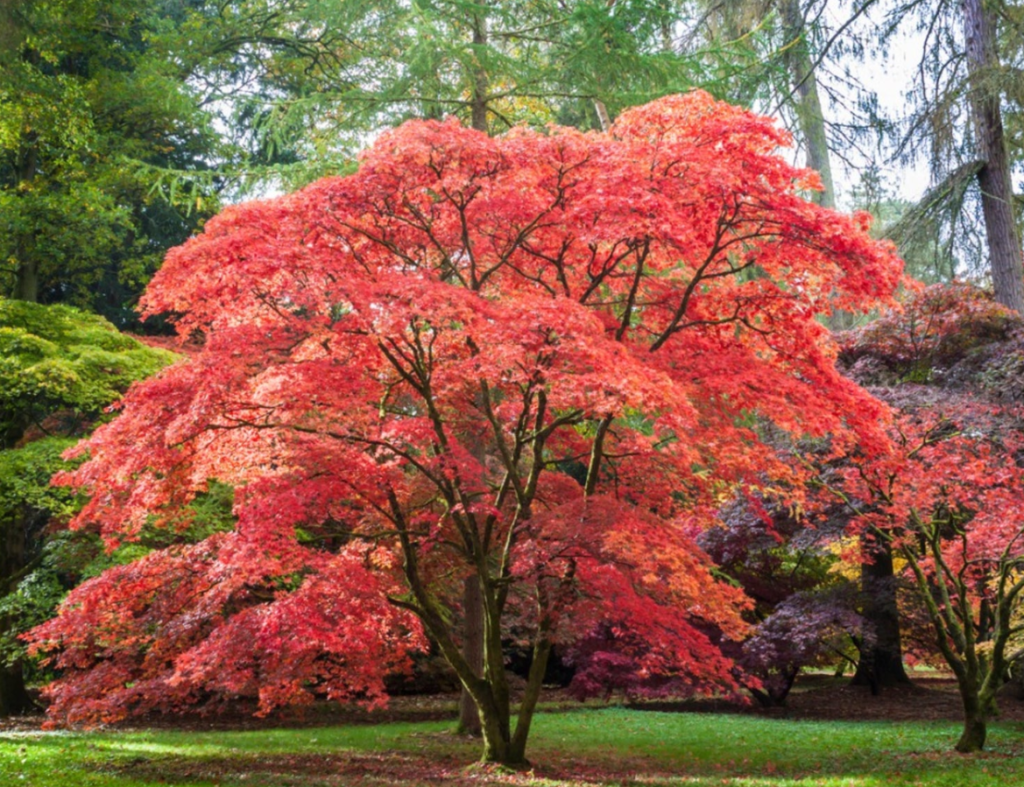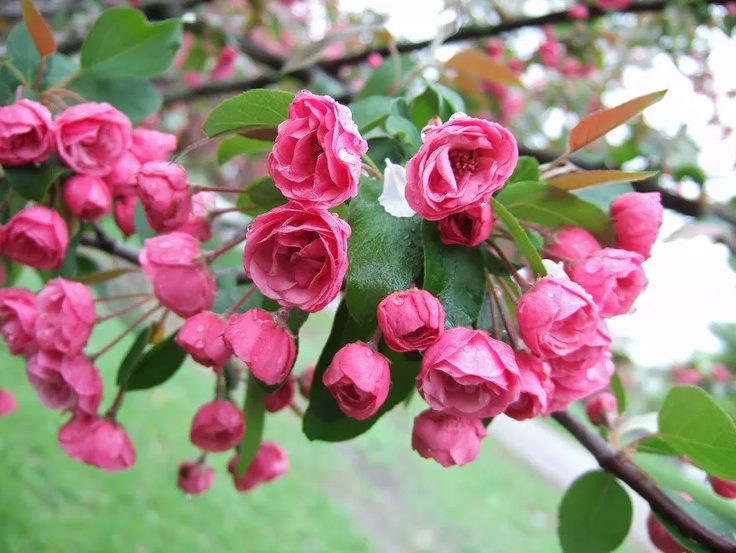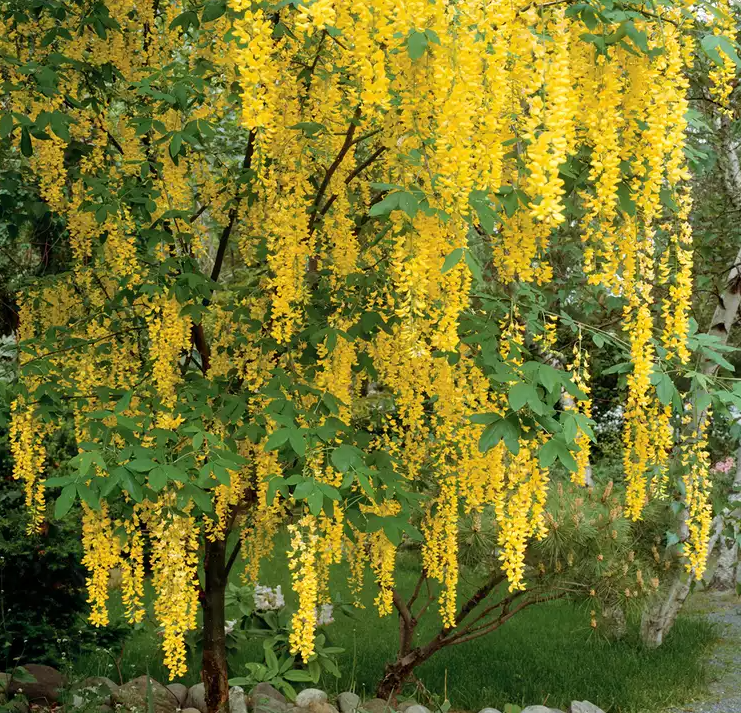mall trees can make a big impact, especially when they are selected for their vibrant colors. Whether it’s their blossoms, foliage, or berries, these trees can dramatically transform your front yard into a lively and eye-catching space. In this guide, we’ll explore the 19 best small trees for front yards that explode with color, providing beauty in every season.
Why Choose Small Trees for Front Yards?
Choosing small trees for your front yard comes with numerous advantages. They’re perfect for framing your home, creating curb appeal, and bringing color to a space without overwhelming it. Some key benefits include:
- Size Appropriateness: Small trees are ideal for compact spaces, ensuring they don’t obstruct views or overpower your home’s architecture.
- Year-Round Interest: Many small trees offer multi-season appeal, with colorful blooms in spring, vibrant foliage in autumn, and structural beauty in winter.
- Easy Maintenance: Smaller trees are typically easier to prune, maintain, and care for, making them perfect for both novice and seasoned gardeners.
How to Select the Perfect Tree for Your Front Yard
When selecting a small tree for your front yard, it’s important to consider several factors such as climate, soil conditions, and the tree’s specific growth habits. You should also think about the desired effect—whether you want year-round color, seasonal blooms, or attractive foliage. Additionally, choosing a tree that complements your home’s style can enhance your curb appeal.
1. Japanese Maple (Acer palmatum)

Known for its stunning foliage, the Japanese Maple is a must-have for any front yard. Its delicate, deeply lobed leaves change color throughout the year, ranging from bright green in spring to deep red or orange in autumn. This tree is perfect for adding a pop of color and texture.
- Height: 10-25 feet
- Bloom Time: Foliage color in fall
- Sun Requirements: Partial shade to full sun
- Best Feature: Brilliant autumn colors
2. Flowering Dogwood (Cornus florida)
The Flowering Dogwood is a classic ornamental tree that bursts with white, pink, or red flowers in spring, followed by vibrant red berries in fall. Its multi-season interest makes it a favorite for front yard landscaping, and it attracts birds and pollinators.
- Height: 15-30 feet
- Bloom Time: Spring
- Sun Requirements: Full sun to partial shade
- Best Feature: Showy spring blossoms and fall berries
3. Redbud (Cercis canadensis)
The Redbud tree is one of the first trees to bloom in early spring, producing clusters of vibrant pink or purple flowers along its branches. Its heart-shaped leaves turn golden yellow in fall, making it a colorful addition to any yard.
- Height: 20-30 feet
- Bloom Time: Early spring
- Sun Requirements: Full sun to partial shade
- Best Feature: Striking pink-purple flowers
4. Crape Myrtle (Lagerstroemia indica)
The Crape Myrtle is known for its long-lasting summer blooms in shades of pink, purple, red, and white. It thrives in warm climates and is a popular choice for adding vibrant color during the hottest months. Its exfoliating bark and colorful leaves in fall add further appeal.
- Height: 15-25 feet
- Bloom Time: Summer to early fall
- Sun Requirements: Full sun
- Best Feature: Extended bloom period and vibrant flower clusters
5. Dwarf Japanese Maple (Acer palmatum var. dissectum)
For those with limited space, the Dwarf Japanese Maple offers the same vivid colors as its larger counterpart but in a more compact form. Its lacy, dissected leaves provide texture, and it shines with red or orange hues in the fall.
- Height: 6-8 feet
- Bloom Time: Foliage color in fall
- Sun Requirements: Partial shade
- Best Feature: Compact size and vibrant autumn colors
6. Saucer Magnolia (Magnolia × soulangeana)
The Saucer Magnolia produces large, fragrant pink-and-white blooms in early spring. Its blossoms are some of the showiest in the tree world, making it a standout in any landscape. This tree also offers attractive foliage during the summer months.
- Height: 20-30 feet
- Bloom Time: Early spring
- Sun Requirements: Full sun to partial shade
- Best Feature: Spectacular large blooms
7. Serviceberry (Amelanchier canadensis)
The Serviceberry is a multi-season tree that explodes with white flowers in early spring, produces edible berries in summer, and showcases beautiful orange-red foliage in the fall. It’s a perfect choice for small yards due to its manageable size.
- Height: 15-25 feet
- Bloom Time: Early spring
- Sun Requirements: Full sun to partial shade
- Best Feature: Multi-season interest with flowers, berries, and fall foliage
8. Ornamental Cherry (Prunus serrulata)
With its delicate, pink-to-white blossoms in spring, the Ornamental Cherry tree is a popular choice for adding beauty and color to the landscape. It’s relatively small, making it perfect for front yards, and its fall foliage adds a warm glow later in the year.
- Height: 15-25 feet
- Bloom Time: Spring
- Sun Requirements: Full sun
- Best Feature: Gorgeous spring flowers
9. Smoke Tree (Cotinus coggygria)
The Smoke Tree stands out for its fluffy, cloud-like flower clusters that appear in late spring, giving the tree a “smoky” appearance. Its leaves turn vibrant shades of orange, red, or purple in fall, providing visual interest throughout the growing season.
- Height: 10-15 feet
- Bloom Time: Late spring to summer
- Sun Requirements: Full sun
- Best Feature: Unique “smoky” flower clusters
10. Hawthorn (Crataegus)
The Hawthorn tree features clusters of white flowers in spring and small red berries in fall, which persist into winter. It’s a great tree for attracting wildlife, and its glossy leaves turn golden in autumn, adding another layer of color to your yard.
- Height: 15-25 feet
- Bloom Time: Spring
- Sun Requirements: Full sun
- Best Feature: Spring blooms and winter berries
11. Dwarf Korean Lilac (Syringa meyeri ‘Palibin’)
The Dwarf Korean Lilac is a compact tree that produces abundant clusters of fragrant purple flowers in late spring. Its small size and beautiful blooms make it perfect for small front yards or as a specimen tree.
- Height: 4-6 feet
- Bloom Time: Late spring
- Sun Requirements: Full sun
- Best Feature: Fragrant, abundant blooms
12. Autumn Brilliance Serviceberry (Amelanchier × grandiflora)
The Autumn Brilliance Serviceberry offers stunning white flowers in spring, followed by purple berries in summer and fiery orange-red foliage in the fall. It’s an excellent tree for small spaces, providing color and interest year-round.
- Height: 15-25 feet
- Bloom Time: Early spring
- Sun Requirements: Full sun to partial shade
- Best Feature: Year-round interest
13. Golden Chain Tree (Laburnum)
The Golden Chain Tree is a showstopper with its drooping clusters of yellow flowers in late spring. It’s ideal for small gardens and makes a striking focal point with its vibrant, golden blooms.
- Height: 10-15 feet
- Bloom Time: Late spring
- Sun Requirements: Full sun to partial shade
- Best Feature: Dramatic, golden flower clusters
14. Sargent Crabapple (Malus sargentii)

The Sargent Crabapple produces profuse white blossoms in spring, followed by small, bright red fruits that persist into winter. Its compact size and multi-season beauty make it a wonderful choice for front yard landscaping.
- Height: 6-10 feet
- Bloom Time: Spring
- Sun Requirements: Full sun
- Best Feature: Spring flowers and winter fruit
15. Eastern Redbud ‘Forest Pansy’ (Cercis canadensis ‘Forest Pansy’)
The ‘Forest Pansy’ Redbud is notable for its deep purple leaves that change to a rich orange in fall. In spring, it bursts into pink flowers that cover the branches before the leaves appear, making it a colorful addition to any landscape.
- Height: 20-30 feet
- Bloom Time: Spring
- Sun Requirements: Full sun to partial shade
- Best Feature: Colorful foliage and blooms
16. Japanese Snowbell (Styrax japonicus)
The Japanese Snowbell produces small, bell-shaped white flowers that hang delicately from its branches in late spring. It’s a compact tree with attractive green foliage that turns yellow in fall, offering subtle beauty to small yards.
- Height: 20-30 feet
- Bloom Time: Late spring
- Sun Requirements: Full sun to partial shade
- Best Feature: Graceful, bell-shaped flowers
RELATED : 10 Best Trees with White Flowers to Brighten Up Your Landscape
17. Dwarf Alberta Spruce (Picea glauca ‘Conica’)
The Dwarf Alberta Spruce is a slow-growing evergreen tree that maintains a conical shape. While it doesn’t flower, its dense, bright green foliage provides a year-round pop of color, making it ideal for borders or as a specimen tree in small spaces.
- Height: 8-12 feet
- Bloom Time: Evergreen
- Sun Requirements: Full sun
- Best Feature: Year-round color and texture
18. Persian Ironwood (Parrotia persica)
The Persian Ironwood is a small, ornamental tree that puts on a fiery display in fall, with leaves turning shades of orange, red, and purple. In late winter, it produces small, red flowers, adding color to the landscape even during the colder months.
- Height: 20-30 feet
- Bloom Time: Late winter
- Sun Requirements: Full sun to partial shade
- Best Feature: Stunning fall foliage
19. Coral Bark Maple (Acer palmatum ‘Sango Kaku’)
The Coral Bark Maple is prized for its striking coral-red bark, which adds a splash of color to the garden in winter. Its bright green leaves turn golden-yellow in fall, providing year-round interest.
- Height: 15-25 feet
- Bloom Time: Fall foliage
- Sun Requirements: Full sun to partial shade
- Best Feature: Winter bark color and fall foliage
Tips for Planting and Caring for Small Front Yard Trees
To ensure your small trees thrive and provide vibrant color, follow these care tips:
- Choose the Right Spot: Ensure the tree has enough space to grow, both above and below ground.
- Water Regularly: Newly planted trees need consistent watering, especially during their first few years.
- Mulch Around the Base: This helps retain moisture, regulate soil temperature, and reduce weeds.
- Prune Properly: Remove dead or diseased branches to encourage healthy growth and shape the tree.
- Fertilize Sparingly: Use a balanced fertilizer if needed, but avoid over-fertilizing, which can harm the tree.
FAQs on Small Trees for Front Yards
1. Can small trees provide shade?
Yes, many small trees, such as the Japanese Maple or Redbud, offer enough coverage to create shade in small areas.
2. Are these trees suitable for containers?
Some smaller varieties, like the Dwarf Japanese Maple or Dwarf Alberta Spruce, can thrive in large containers with proper care.
3. How often should I water newly planted trees?
Water newly planted trees deeply once a week, ensuring the water reaches the tree’s roots.
4. How do I protect my small trees from pests?
Regularly inspect your trees for signs of pests. Using organic or chemical treatments as needed can prevent infestations.
5. When is the best time to plant these trees?
The best time to plant small trees is in early spring or fall when temperatures are mild.
6. Can small trees thrive in urban environments?
Yes, many small trees are perfect for urban yards, as they are tolerant of compact spaces and can handle some pollution.

